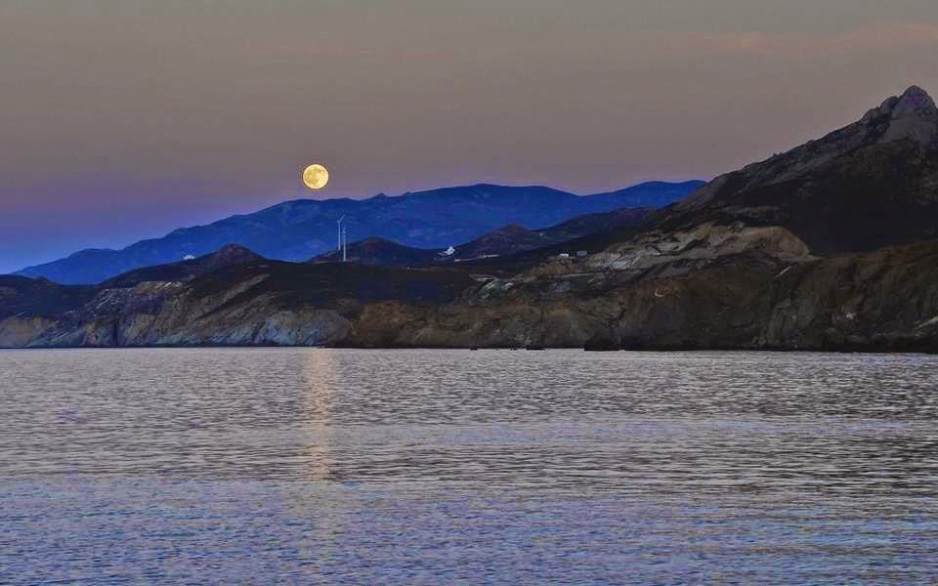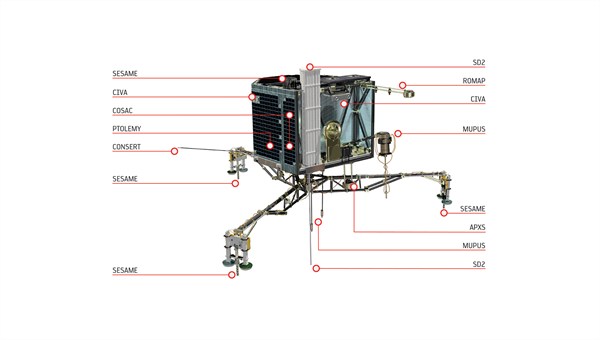Das Landegerät der Rosetta-Mission mit Namen Philae - ein High-Tech-Würfel mit einer Kantenlänge von etwa einem Meter - ist bestückt mit zehn wissenschaftlichen Instrumenten. Seine Hauptaufgabe ist die Vor-Ort-Analyse des Kometenmaterials, des wohl ursprünglichsten und ältesten Materials, das es in unserem Sonnensystem gibt. Insbesondere sollen Element- und Isotopenverteilung, organische Moleküle sowie Minerale und Eise untersucht werden. Bei der Analyse der Struktur und Eigenschaften des Kometenkerns geht es vor allem um die Oberflächenbeschaffenheit, die physikalischen Eigenschaften des Kometenkerns sowie die Schichtungsstruktur und die globale interne Struktur. Zudem sollen die Auswirkungen zeitlicher Variationen beobachtet und untersucht werden, die durch den Tag- und Nachtzyklus sowie die Schweifbildung bei der Annäherung an die Sonne entstehen.
Der Lander ist auf nahezu allen Seiten mit Solarzellen verkleidet, die im Mittel etwa acht Watt an elektrischer Energie für die wissenschaftlichen Experimente erzeugen können. Da die verfügbare Sonnenenergie in diesem sonnenfernen Bereich nur etwa ein Zehntel der erdnahen beträgt, ist die erzeugbare Energie auf einem Kometen ein knappes und wertvolles Gut. Der Lander hat zusätzlich Primär- und Sekundärbatterien zum Zwischenspeichern der Energie, und er verfügt über warme und kalte Bereiche, also Bereiche, die geheizt werden, um ein besseres Funktionieren der Experimente zu ermöglichen, und Bereiche, die nur durch Isolationsfolie vor der stets kalten Umgebung (minus 50 Grad Celsius bis minus 170 Grad Celsius) geschützt sind. Alle Vorgänge auf dem Lander werden von einem zentralen, redundant ausgelegten Bordcomputer geregelt.
Die zehn Instrumente des Landegeräts:
APX (Alpha-Particle-X-Ray-Spectrometer)
APX (Alpha-Particle-X-Ray-Spectrometer) ist ein Spektrometer zur Untersuchung der Elementzusammensetzung der Materie direkt an der Oberfläche des Kometen. Principal Investigator (PI): Göstar Klingelhöfer, Johannes Gutenberg-Universität, Mainz, Deutschland.
CIVA (Comet Infrared and Visible Analyzer)
CIVA besteht aus dem abbildenden Panorama-Kamerasystem zur Untersuchung des Landeplatzes und Mikroskopen zur Abbildung und Spektroskopie der mit dem Bohrer SD2 gewonnenen Materialproben aus der Kometenoberfläche.
Principal Investigator (PI): Jean-Pierre Bibring, Institut d'Astrophysique Spatiale, Université Paris Sud, Orsay, Frankreich.
CONSERT (Comet Nucleus Sounding Experiment by Radio wave Transmission)
CONSERT ist eine Radiowellen-Sonde zur Tomografie (Durchleuchtung) des Kometenkerns im Zusammenspiel mit dem Orbiter.
Principal Investigator (PI): Wlodek Kofman, Institut de Planétologie et d'Astrophysique de Grenoble, Grenoble, Frankreich.
COSAC (Cometary Sampling and Composition)
COSAC dient der Bestimmung der elementaren, isotopischen und chemischen Zusammensetzung der gefrorenen Komponenten der Kometenoberfläche bis in rund 30 Zentimeter Tiefe. Das Instrument beinhaltet ein Massenspektrometer und einen Gaschromatographen und wird vor allem die organischen Komponenten (falls vorhanden auch zum Beispiel Aminosäuren) analysieren.
Principal Investigator (PI): Fred Goesmann, Max-Planck-Institut für Sonnensystemforschung, Katlenburg-Lindau, Deutschland.
MUPUS (Multi-Purpose Sensors for Surface and Subsurface Science)
MUPUS misst mit mehreren Sensoren die Oberflächentemperatur und oberflächennahen Temperaturprofile, die thermische Leitfähigkeit des Oberflächenmaterials sowie die Festigkeit der kometaren Materie. Die wichtigsten wissenschaftlichen Ziele von MUPUS sind die Bestimmung der thermischen und mechanischen Eigenschaften der äußeren Schichten eines Kometen, die Bestimmung der Energiebilanz der kometaren Oberfläche sowie der Grenzschichten. Durch die Ergebnisse dieses Instruments sollen die Mechanismen kometarer Aktivität verstanden werden sowie Aussagen über die Ursprünglichkeit der Materie getroffen werden können. Außerdem unterstützt es die kosmochemischen Experimente des Philae-Landers.
Principal Investigator (PI): Tilman Spohn, Institut für Planetenforschung, Deutsches Zentrum für Luft- und Raumfahrt, Berlin, Deutschland.
Co-Investigatoren: Matthias Grott, Jörg Knollenberg, Ekkehard Kührt, Institut für Planetenforschung, Deutsches Zentrum für Luft- und Raumfahrt, Berlin, Deutschland.
PTOLEMY
PTOLEMY ist ein Massenspektrometer mit vorschaltbarem Gaschromatographen zur Untersuchung der isotopischen Zusammensetzung der Bohrproben.
Principal Investigator (PI): Ian Wright, Open University, Milton Keynes, Großbritannien.
ROLIS (Rosetta Lander Imaging System)
ROLIS ist eines der zwei Kamerasysteme auf dem Rosetta Lander Philae. Mit der miniaturisierten CCD-Kamera wird ROLIS Bilder von der Landestelle auf dem Kometen während des Abstiegs vom Orbiter aufnehmen, und zwar mit immer höherer räumlicher Auflösung. Nach der Landung wird ROLIS sich auf einen Abstand von 30 Zentimeter fokussieren, um Bilder von der Kometenoberfläche unterhalb des Landers aufzunehmen. Multispektrale Aufnahmen werden mittels einer Lampe ermöglicht, die mit vier monochromatischen Leuchtdioden in den Spektralbereichen 470, 530, 640 und 870 Nanometer ausgestattet ist. Die Stelle, wo Bohrproben entnommen werden, sowie das Gebiet, das mit dem Alpha X-Ray Spektrometer (APXS) untersucht werden soll, werden abgebildet, um Aufnahmen des Umfeldes zu erhalten, damit diese mit den Messungen des In situ-Analysators verglichen werden können. Nach Abschluss der Bohrungen soll das Bohrloch inspiziert werden, um dessen Morphologie zu studieren und um nach Anzeichen von unterschiedlichen Schichten (Stratifizierungen) zu suchen. Durch die Rotationsmöglichkeit des Landers können Stereobildpaare aufgenommen werden, was das Kartographieren und die Identifikation der Oberflächenstrukturen erleichtern soll.
Principal Investigator (PI): Stefano Mottola, Deutsches Zentrum für Luft- und Raumfahrt, Berlin, Deutschland.
Co-Investigatoren: Gerhard Hahn, Ralf Jaumann, Gabriele Arnold, Institut für Planetenforschung, Deutsches Zentrum für Luft- und Raumfahrt, Berlin, Deutschland.
ROMAP (Rosetta Lander Magnetometer and Plasmamonitor)
ROMAP ermittelt das Magnetfeld des Kometen und seine Plasmaumgebung.
Principal Investigator (PI): Hans-Ulrich Auster, Technische Universität, Braunschweig, Deutschland; István Apáthy, KFKI , Budapest, Ungarn.
SD2 (Sample, Drill and Distribution)
SD2 ist ein Bohrmechanismus zur Gewinnung von Proben aus bis zu 30 Zentimeter Tiefe.
Principal Investigator (PI): Amalia Ercoli-Finzi, Politecnico di Milano, Mailand, Italien.
SESAME (Surface Electric Sounding and Acoustic Monitoring Experiment)
SESAME umfasst Sensoren zur Messung der akustischen und dielektrischen Eigenschaften des Kometenkerns und seiner oberflächennahen Struktur sowie einen Partikeleinschlag-Monitor. SESAME besteht aus den Instrumenten CASSE, DIM und PP.
Das Instrument CASSE (Cometary Acoustic Surface Sounding Experiment) wird mittels akustischer Methoden die Struktur des Materials unter der Kometenoberfläche untersuchen. Es bietet zwei Messmöglichkeiten: eine passive, die, ähnlich einem Seismometer, in den Kometen hineinhorcht und eine aktive, die, ähnlich einem Echolot, eine Sondierung der Oberflächenschichten durchführt
Der Dust Impact Monitor (DIM) registriertdie Signale, die durch den Aufprall kometarer Staub- und Eisteilchen auf einem Sensor-Würfel entstehen.. Aus den Messungen können Anzahl, Masse und Geschwindigkeit der Teilchen ermittelt werden.
Das Instrument Permittivity Probe (PP) bestimmt den Wassereisgehalt in der kometaren Oberflächenschicht und seine Veränderung mit der Zeit. PP verwendet dazu die Quadrupoltechnik, bei der zwei Elektroden, verbunden mit einem Wechselstromgenerator, einen variablen Strom im Kometenboden induzieren.
Principal Investigator (PI): Klaus Seidensticker, Institut für Planetenforschung, Deutsches Zentrum für Luft- und Raumfahrt, Berlin, Deutschland; István Apáthy, KFKI , Budapest, Ungarn.
Co-Investigatoren: H.-H. Fischer, Martin Knapmeyer, Institut für Planetenforschung, Deutsches Zentrum für Luft- und Raumfahrt, Berlin, Deutschland.








